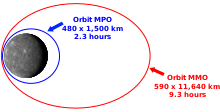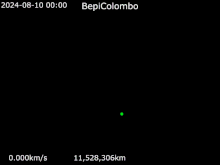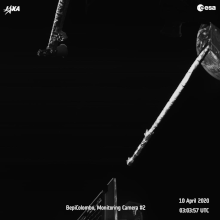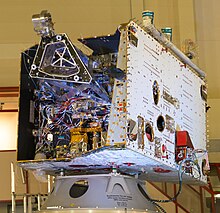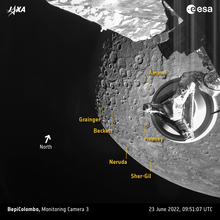
The Mariner program was conducted by the American space agency NASA to explore other planets. Between 1962 and late 1973, NASA's Jet Propulsion Laboratory (JPL) designed and built 10 robotic interplanetary probes named Mariner to explore the inner Solar System - visiting the planets Venus, Mars and Mercury for the first time, and returning to Venus and Mars for additional close observations.
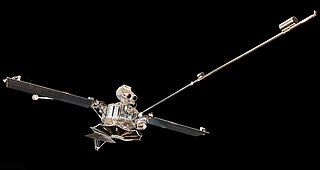
Mariner 10 was an American robotic space probe launched by NASA on 3 November 1973, to fly by the planets Mercury and Venus. It was the first spacecraft to perform flybys of multiple planets.

A gravity assist, gravity assist maneuver, swing-by, or generally a gravitational slingshot in orbital mechanics, is a type of spaceflight flyby which makes use of the relative movement and gravity of a planet or other astronomical object to alter the path and speed of a spacecraft, typically to save propellant and reduce expense.

SMART-1 was a Swedish-designed European Space Agency satellite that orbited the Moon. It was launched on 27 September 2003 at 23:14 UTC from the Guiana Space Centre in Kourou, French Guiana. "SMART-1" stands for Small Missions for Advanced Research in Technology-1. On 3 September 2006, SMART-1 was deliberately crashed into the Moon's surface, ending its mission.
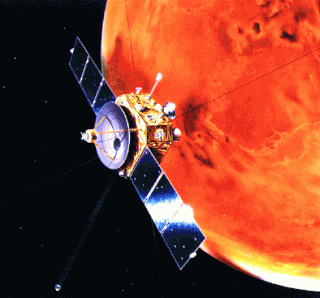
Nozomi was a Japanese Mars orbiter that failed to reach Mars due to electrical failure. It was constructed by the Institute of Space and Astronautical Science, University of Tokyo and launched on July 4, 1998, at 03:12 JST with an on-orbit dry mass of 258 kg and 282 kg of propellant. The Nozomi mission was terminated on December 31, 2003.
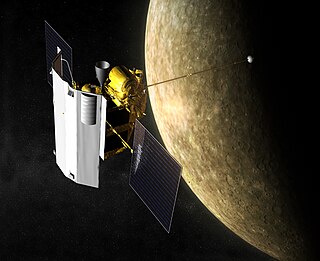
MESSENGER was a NASA robotic space probe that orbited the planet Mercury between 2011 and 2015, studying Mercury's chemical composition, geology, and magnetic field. The name is a backronym for "Mercury Surface, Space Environment, Geochemistry, and Ranging", and a reference to the messenger god Mercury from Roman mythology.

Solar electric propulsion (SEP) refers to the combination of solar cells and electric thrusters to propel a spacecraft through outer space. This technology has been exploited in a variety of spacecraft designs by the European Space Agency (ESA), the JAXA, Indian Space Research Organisation (ISRO) and NASA. SEP has a significantly higher specific impulse than chemical rocket propulsion, thus requiring less propellant mass to be launched with a spacecraft. The technology has been evaluated for missions to Mars.

The gridded ion thruster is a common design for ion thrusters, a highly efficient low-thrust spacecraft propulsion method running on electrical power by using high-voltage grid electrodes to accelerate ions with electrostatic forces.
Giuseppe "Bepi" Colombo was an Italian scientist, mathematician and engineer at the University of Padua, Italy.

The Solar Orbiter (SolO) is a Sun-observing probe developed by the European Space Agency (ESA) with a National Aeronautics and Space Administration (NASA) contribution. Solar Orbiter, designed to obtain detailed measurements of the inner heliosphere and the nascent solar wind, will also perform close observations of the polar regions of the Sun which is difficult to do from Earth. These observations are important in investigating how the Sun creates and controls its heliosphere.

Observations of the planet Venus include those in antiquity, telescopic observations, and from visiting spacecraft. Spacecraft have performed various flybys, orbits, and landings on Venus, including balloon probes that floated in the atmosphere of Venus. Study of the planet is aided by its relatively close proximity to the Earth, compared to other planets, but the surface of Venus is obscured by an atmosphere opaque to visible light.

The exploration of Mercury has a minor role in the space interests of the world. It is the least explored inner planet. As of 2015, the Mariner 10 and MESSENGER missions have been the only missions that have made close observations of Mercury. MESSENGER made three flybys before entering orbit around Mercury. A third mission to Mercury, BepiColombo, a joint mission between the Japan Aerospace Exploration Agency (JAXA) and the European Space Agency, is to include two probes. MESSENGER and BepiColombo are intended to gather complementary data to help scientists understand many of the mysteries discovered by Mariner 10's flybys.

Mercury, being the closest to the Sun, with a weak magnetic field and the smallest mass of the recognized terrestrial planets, has a very tenuous and highly variable atmosphere containing hydrogen, helium, oxygen, sodium, calcium, potassium and water vapor, with a combined pressure level of about 10−14 bar. The exospheric species originate either from the Solar wind or from the planetary crust. Solar light pushes the atmospheric gases away from the Sun, creating a comet-like tail behind the planet.

Energetic Neutral Atom (ENA) imaging is a technology used to create global images of otherwise invisible phenomena in the magnetospheres of planets and throughout the heliosphere.
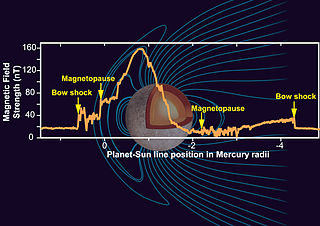
Mercury's magnetic field is approximately a magnetic dipole apparently global, on planet Mercury. Data from Mariner 10 led to its discovery in 1974; the spacecraft measured the field's strength as 1.1% that of Earth's magnetic field. The origin of the magnetic field can be explained by dynamo theory. The magnetic field is strong enough near the bow shock to slow the solar wind, which induces a magnetosphere.

Hisaki, also known as the Spectroscopic Planet Observatory for Recognition of Interaction of Atmosphere (SPRINT-A) was a Japanese ultraviolet astronomy satellite operated by the Japan Aerospace Exploration Agency (JAXA). The first mission of the Small Scientific Satellite program, it was launched in September 2013 on the maiden flight of the Epsilon rocket. It was used for extreme ultraviolet observations of the Solar System planets.
OKEANOS was a proposed mission concept to Trojan asteroids, which share Jupiter's orbit, using a hybrid solar sail for propulsion; the sail was planned to be covered with thin solar panels to power an ion engine. In situ analysis of the collected samples would have been performed by either direct contact or using a lander carrying a high-resolution mass spectrometer. A sample-return to Earth was an option under study.

Ariane Flight VA245 is the Ariane 5 space launch of BepiColombo that took place on 20 October 2018 at 01:45:28 UTC from the Guiana Space Centre. It was the 101st launch of Ariane 5, and the 301st Arianespace mission.


